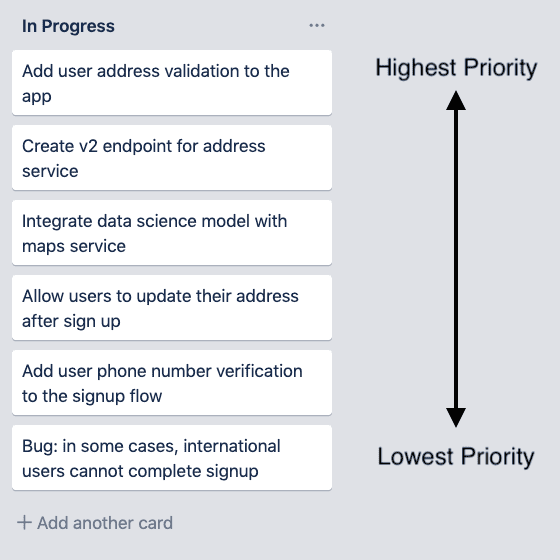Your Standups Probably Suck
July 01, 2019
Most daily standup meetings are basically the same. Every morning you get together for 15 minutes. You go one at a time around the room, answering the same three questions.
- What did you do yesterday?
- What do you plan to do today?
- Is anything blocking you?
But what does it get you? A pointless meeting that no one likes, where everyone checks out—going through the motions of giving their update day after day. It doesn’t help you find and fix issues before it’s too late, it doesn’t help you work better as a team, and it doesn’t help you get things done. And yet you do it anyway because “it’s what good agile teams are supposed to do.”

This sucks! This isn’t what standups are about. If you look back to the origins of standup, they are about helping your team organize around the day’s goals and challenges—with teammates helping each other out when they get stuck or preventing everything from going off track.
It seems like so many fall into the same three questions trap. This around-the-room-three-question style pressures people to make themselves sound busy, so you get worthless updates. “What will they think if they know I didn’t do anything yesterday?” Even worse, it means everyone is focused on their individual updates while ignoring the rest of the team.
Making Standup Not Suck
So what are you to do? Maybe you should just accept that this is the way things are and move on.
No way! It doesn’t have to be like this. It doesn’t have to suck! You can break free from the confines of the same-old meetings. You can live in a world where you actually value your standup meetings. So if you’re ready to take advantage of all that standups have to offer just follow three steps:
- Gather the Right People
- Walk the Board
- Set Daily Goals
Gather the Right People
Hands down the most common mistake teams make in standup is not including the right people. Who are the right people? Well, it’s tricky. It’s hard to know who these people are because, like most tough problems, the answer is that it depends.
It depends heavily on your organization, its structure, your team structure, and what you’re building. In general though if the only people in your standup are engineers, then you’re missing out.
Members from non-engineering teams like Product, Design, Infrastructure/Ops, and more play a vital role in a healthy standup meeting. A good rule of thumb is: if you depend on them to get your day-to-day work done, they should be represented in standup. Don’t be afraid to ask people from these teams to join in on an as-needed basis.
For example, are you working closely with the design team to create mocks for an upcoming feature? Have one of the designers join the standup. Need help prioritizing two competing tasks? You need the product owner there to help get to the right decision.

Cross-Team Liaisons
But what about when you depend on another engineering team? Perhaps your work is frontend-focused, but you need a new API built by a backend team. These kinds of dependencies will grind your organization to a halt if you’re not careful. In an ideal world, every team would be autonomous—not needing anyone else to get things done. You want to use Conway’s Law to your advantage. However, that isn’t always possible.
When this happens, try using a Cross-Team Liaison. Simply have the tech-lead (or equivalent) of the other team join your standups. This helps the lead to understand the why behind their work and provides a fantastic opportunity for collaboration. You don’t need the liaison in your stand up every day—just when it makes sense.
Filter Out the “Wrong” People
Unfortunately, including the right people in your meeting isn’t always enough. Do you ever have that one type of person attend your meetings? You know the ones. They only show up when they need to pressure your team into getting something done for them. But they don’t trust you can get it done, so they come asking all sorts of odd questions.

These are the “wrong” people, and you should deal with them outside of standup. They prevent teammates from helping each other solve real problems by distracting them with artificial pressure and make-believe deadlines. Sometimes they can even derail an entire meeting to talk about one issue.
Instead of standup, direct them through controlled channels for status updates like a project manager, Jira, or a separate meeting without the full team. Focus on building trust with them through transparency and delivering consistently. This will make for a win-win for everyone and free your standups from distractions.
Walk the Board
Getting the right people together is a good start, but you’ve got to think bigger. To break away from the firm grasp of the three questions, we have to make even more drastic changes! The single most meaningful thing you can do to improve your standups is ditch Around the Room in favor of Walk the Board.
The Walk the Board style keeps things very delivery-focused and team-focused. If your team lacks a sense of urgency, struggles to get things done on time, or has difficulty with team ownership of tasks, I guarantee this shift alone will change everything.

So how is this different? Instead of starting off by going one-by-one giving updates, look at your task board. First, make sure it’s well prioritized, with the most critical issues at the top. Then drive your conversation by discussing your highest priority items first, and for each item asking, “Is this still on track to be completed on time?” If it isn’t, figure out what you can do to help get it back on track.
So let’s break this down a little. First up is prioritization. You need to know what are the most valuable things you’re working on at all times. This requires continuous input and adjustment from your product owner. Prioritizing your board should be an ongoing and everyday process. If two items are competing for the top spot, it’s the team’s job to make the call of which one is number one. Without this Walking the Board doesn’t work.
Next up is making sure things are on track. This gets at the core problem with the three questions: finishing work. The questions only concern themselves with progress, not completion. “Will this still be done on time?” lets you answer questions about the progress you’ve made without losing sight of the bigger picture.
As you’ll start to see, things often go off track. But that’s ok! Embrace it! Instead, focus on how you can help get it where it needs to be. Can someone pause working on a lower-priority issue to help with this one? Maybe if it’s way behind, the team should swarm on it. Or perhaps there’s a way to trim the scope with a little help from your product owner. The point is to center your conversation around how to get work past the finish line.
Walking the Board also helps identify when one person is trying to take on too much. Did the same person just talk about finishing the three highest priority items? Then get your teammates involved working on the other two.
Though it’s not immediately obvious, making Walk The Board work is all about helping each other out. Switch task owners, trim the scope, pair program, or swarm if you need to. Do what it takes to make your team successful.
Set Daily Goals
How does a project get to be a year late?… One day at a time.
☝️ This is a timeless quote from the The Mythical Man Month and it holds true for every project I’ve ever worked on. So many teams fail each day before they even get started. And it’s so easy to see, yet no one notices.
An engineer will start off the day saying, “I’m going to work on Task X today.” Then they go off and work diligently all-day. Then they come back the next day and…nothing. No progress was made on Task X. But how?
You ask them about it, and you find out while working on Task X, something unexpected came up. The engineer assures you that what they worked on was more important than Task X. But you know it really wasn’t. This is called yak shaving, and it’s all too common. The good news is that it’s preventable.

If only there were some way to have that engineer know that nothing was a higher priority than Task X. That’s where Daily Goals 🥅 come in.
It’s simple: at the end of your daily standup, after you’ve Walked the Board, ask your team, “What do we need to get done today?” Initially, however, you may get silence when asking. So for the first few times, you may have to say something like, “Ok. So to recap, we’re looking to get X, Y, and Z done today. Does that sound good to everyone?”
This leaves no ambiguity as to what that team’s daily priorities are. Everyone is aligned. If you’re not directly working towards a daily goal, you can indirectly help others to do so. Perhaps they need a code review or some help debugging. The team (not the individual) hitting their target is what matters.
Tracking Daily Goals
After you’ve agreed on your goals, write them down and make them visible. My team used to save our goals as a checklist in Slack each day. Writing them down and tracking them allows you to review them during the next day’s standup.
Why did we miss this goal? You might have work that’s not visible—like unplanned worked. Or perhaps it was just some yak shaving, and we can talk about it in our retrospective. Whatever the reason, reviewing the goals affords a place to figure out why things might be going off track.
Something important to watch out for is creating a bunch of individual goals. Daily Goals should only be team goals. And you probably don’t want to set more than three goals per day. Most importantly, keep them achievable and high-value. This allows your team to be well-aligned and focused on the right outcomes.
Finally, understand that not everyone needs to be working directly towards a daily goal. There are alternative ways to help, like code reviews. The purpose of these goals is to help your team’s day-to-day decision-making.
Effective Standups
So hopefully after you’ve rid yourself of those same three questions and that familiar Around the Room format, you can begin to appreciate standup meetings for what they’re meant to be: a place for your team to game plan for the day and support one another. Go and transform your sucky, 15-minute status update meeting into something you can’t live without.
Hi! 👋 I'm William Seward. I'm a software engineer and this is my blog. If you like what you're reading, then follow me on Twitter.

